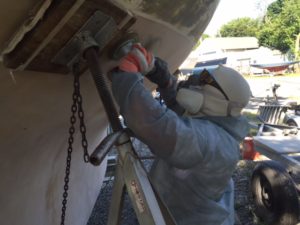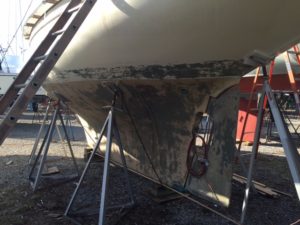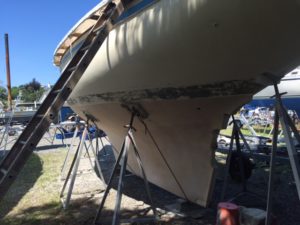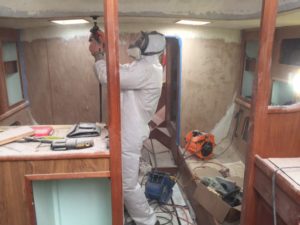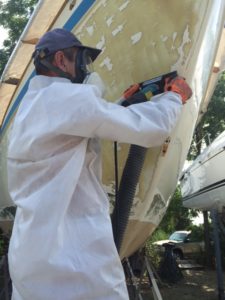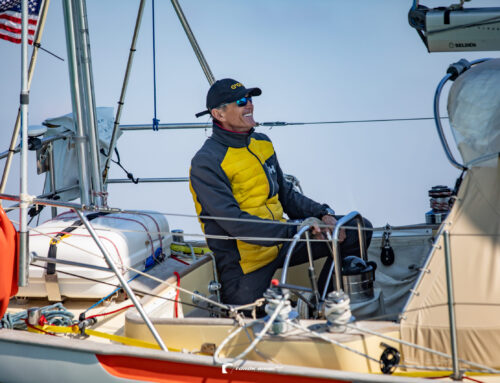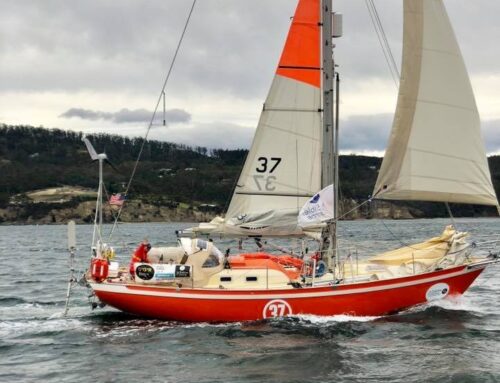Our work on Puffin in July was challenging and intense and involved some serious heavy lifting. Fortunately, one of my friends from Florida, Janos Szalas, volunteered to join me in this “sport.” His dream is to sail Puffin to England with me, and he definitely needed to focus on this goal to keep himself motivated these last few weeks! July is the hottest month of the year in New York, and working outside was not fun—especially dressed up like astronauts in Tyvek Coveralls and protective face masks. But sanding and peeling off the gelcoat and prepping the hull for the reinforcing lamination could not be done without these fashionable Halloween costumes.
We started with the bottom of the boat (under the waterline), which I had fortunately already sandblasted last year prior to Puffin‘s transportation. Nonetheless, sanding off the remaining paint residue still took the two of us three full days of work to complete. We started every morning at 5am and finished around 7pm, with a couple hours set aside for a Spanish-style lunch break due to the intense heat at midday.
The weather dictated how and when we could work on the boat’s exterior; we often had to transition to working inside the boat during afternoon thunderstorms. We ground off the gelcoat on the deck around and under the chainplates, cleats, and windlass, and prepped the cockpit for its new layout (allowing for propane storage). We also cleaned up the interior. It was a really messy job removing the gluey residue of the deteriorated foam from the former headliners, which was clinging to the ceiling and bulkheads with the tenacity of kamikaze leeches. The most effective tool on this front was the grinder, though it can do more harm than good in exhausted hands.
A big surprise awaited me in the forepeak. I went to work grinding the inside of the bow around the stringers to prep the area for fiberglass reinforcement for the staysail’s forestay. I ground off a lot of paint (topcoat type), but I quickly ended up with a forepeak full of sunlight rather than fiberglass! There was essentially no fiberglass at all beneath the layer of paint. I’m all for having good visibility in the front of the boat, but not from the forepeak below deck!
This unpleasant discovery was the last straw in my decision to add extra lamination to the entire hull. Consequently, removing the gelcoat from the topsides was the next challenge on our to-do list. I started with the starboard bow with a borrowed gelcoat peeler, which is a plane with two three-inch-long blades rotating at a very high RPM. We studied the training video prior to putting the peeler into action, but our diligent preparation unfortunately proved to be inadequate. We did not set the peeling depth correctly, and before I was able to discover our error I had already cut DEEP into the fiberglass. After this costly mishap I felt as if I had cut the blades into my own flesh, and my frustration could not be overstated. But I was already past the point of no return…
I decided to adjust the blades to a much more conservative depth, which meant I would only be peeling off the majority of the gelcoat rather than completely removing it. This approach was necessary in order to save the fiberglass underneath, but it would also require an extra week of work with soft pad sanders to get the job done. It was a necessary evil; I could not “bleed” any further than I already had.
Finally, after two weeks of really hard work, the hull was ready for the lamination process.
Now it was time for us to go shopping. We would need—at a minimum—30 gallons of resin and 210 yards of 50-inch-wide fiberglass cloth.
To be continued in Part 3!


